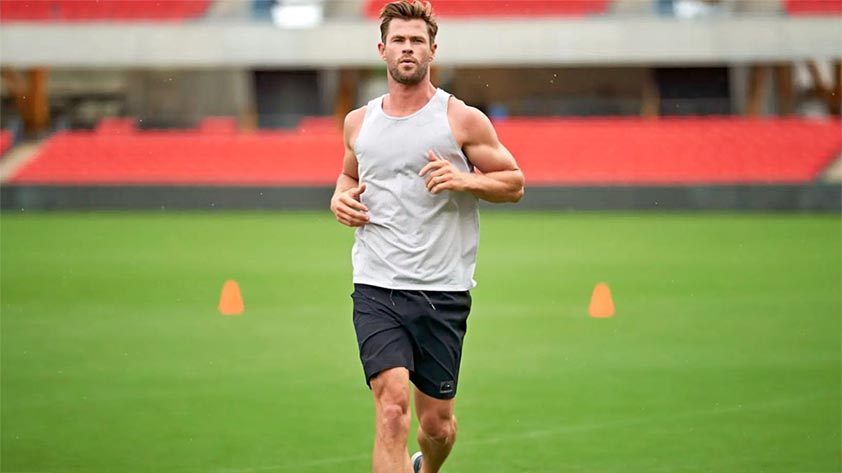
“Limitless” is a National Geographic and Disney+ original series created by Darren Aronofsky, in which the Hollywood movie star Chris Hemsworth, explores the idea of combating ageing and discovering the full potential of the human body.
Utilizing new scientific research guided by scientists, psychologists, physiologists and other experts, the ‘Thor’ superhero actor discovers methods which teach us how to combat ageing to live a healthy and fulfilling life. Curious? Then follow on for our Limitless with Chris Hemsworth review and the 3 Key Lessons that He Learned from being on the TV show!
In an attempt to engineer his psyche and body to add vital years, each episode focuses on a different, extraordinary challenge for Hemsworth where he learns first-hand how to manage stress, increase his immune system power, maximise physical strength, explore the benefits of fasting, reinforce memory and how to emotionally deal with ageing.
The science is put to the test by Hemsworth who, despite being in peak superhero condition, is on a personal mission to learn how to extend health, and further heighten intellect after learning of his high Alzheimer’s risk.
1. Acceptance
In the finale of the series, Hemsworth, by that point, undertook ultra-difficult trials and challenges in an attempt to delay the ageing process. Now, he is facing his most extreme emotional challenge: spend three days in a retirement village, while wearing a suit created by the Massachusetts Institute of Technology’s: AgeLab by Joseph Coughlin, called the “Age Simulation Suit”.
The suit, which has been precisely calibrated to his physique, made the famous actor jump 50 years into the future by impairing his vision and hearing, restricting his movement, and balance while carrying an additional 30 pounds of weight around various parts of his body. In our Limitless Chris Hemsworth review, we get into the final challenge that he was to undergo – various mental tasks in the ultimate accelerated version of ageing.
Dr. Peter Attia, a longevity physician at Attia Medical points out how ‘’we are living amidst an epidemic of denying ageing and death’’, which causes stress and as a result ‘’is bad for blood pressure, bad for hormonal life, for our neurochemistry, and has a direct physiological effect on our bodies’’, he adds how stressing over our age can ‘’significantly shorten life expectancy’’.
The Canadian physician mentions how multiple peer-reviewed studies suggest that if we embrace that reality, and accommodate to being older ‘’you’ll be happier, less depressed and actually live longer, and not just by a day – but potentially years’’. Scientists who developed the suit Chris is wearing, observed how people who wear it go through three distinct phases.
The first is denial, where they try to fight the suit – something Hemsworth himself was undeniably doing in the final episode, during an aerobic class and ping-pong game – which he lost to a real 70 year-old. Chris was incredibly uncomfortable and tense during the initial stage of wearing the suit, facing the reality of the deterioration of physical abilities.
When that happens, Modupe Akinola, Ph.D., a stress researcher at Columbia Business School, explains that Chris is losing more than a calm mind. When left untreated, chronic stress would be posing a real risk to Hemsworth’s long-term health.
Akinola’s work examines how stress may affect all aspects of health, from how tense and anxious you feel in stressful situations, and that relationship to how long you live. The psychologists, help Hemsworth better deal with his anxiety by teaching him powerful physical and psychological techniques which he could inject into some of the more stressful situations to ease his mind.
One of the techniques she uses is to first acknowledge the stress and change the dominant narrative that he has about stress. Instead of avoiding, reducing and running away from it ‘’welcome it, acknowledge it exists’’. She points out how ‘’stress was designed to develop our bodies and we are supposed to have these reactions to uncertain situations’’.
We should therefore act on the stress, and trick the mind to be positive about it. By changing the narrative, you can control your reaction to it and your experience with stress, to achieve a far more desirable outcome.
2. Adaptation
The second stage of the suit Chris Hemsworth is challenged to wear is the adaptive response. Where instead of fighting the suit, you work with it ‘hack it’, and adjust.
Dr. BJ Miller, a palliative care doctor and president of Mettle Health, on day two of the challenge, introduces the movie actor to a few elderly people in the care home village where they share some of their personal life stories.
Chris meets Gary Khor, an elderly man who in his younger days was a Kung Fu Grandmaster, wining multiple titles and awards. Due to a knee injury and old age, the fighting master had to abandon his passion for the art, which was a major part of his identity.
Gary revealed how he struggled to abandon his love for Kung Fu, but he had to adapt to his new situation and physicality, and that is when Tai Chi came in. A slow-motion type of exercise which instead of strength, focused on balance and flexibility – something he could do with ease.
Gary’s philosophy and story helped Chris realize that in truth, you will get old – and your body will fail. However the new passion he found was something that developed him further, a different experience to explore a ‘’new way of connecting to his physicality, a new way of living’’. If our bodies are getting weaker, we can find other ways and adapt, that is something humans shine at when coming up against limits.
The important lesson the elderly man teaches the actor is that there are ways to continue to live life, you can expand yourself, re-imagine and discover a deeper understanding of your own self – simply letting the change happen.
Building a stronger sense of self, to accommodate fragility and vulnerability is one of the greatest perspectives one can have when it comes to dealing with old age.
3. Embracing Mortality
The final mental challenge on day three was for Chris to face his own, and his loved ones’ mortality. Dr. Peter Attia says, ‘’From data, we are less afraid of our own death, than the death of the people we care for’’. He then introduced Chris Hemsworth to two more people, where Chris learned from their experiences, the reality of death.
Another elderly man he met in the care home village was a man called Aiesa – a man from Fiji who had an interesting story to tell Chris. Aiesa had an older brother back in his home country, he recalls ‘’We did everything together, I loved my brother and he taught me everything I know, more so than my own father’’.
In Fiji, his father was chief, meaning he was the leader in the village they lived in. After his father passed away, it was his older brother who had to become chief – Unfortunately, his brother passed away earlier than expected.
Traditionally in Fiji, there is a 100-day mourning period, where the whole village grieves the loss. During those 100 days, Aiesa recalls how much he struggled with his brother’s death, but ‘’a 100 days is a long time’’. He had time to think, learn, and grow – he knew ‘’I had to put on my brother’s shoes’’ and do his best, ‘’and I was a good chief’’ he said.
There are many lessons to learn from Aiesa’s story. One is the importance of giving ourselves time and space to reflect on incredibly difficult feelings. Life includes unimaginable sorrow, sadness but ageing is not the enemy. Some should see themselves as privileged that they had the opportunity to even age – ‘’Death and age is not the enemy, it is part of the deal’’.
Dr Peter Attia says he wanted Chris Hemsworth to learn that having people around you that you love, who you can create memories with is all that matters, he states ‘’Where there is love, there is loss, it’s not ‘if’ it’s ‘when’.’’
The final incredible emotional trials are where the Marvel Cinematic Universe Thor ‘Love & Thunder’ hero star, with the help of Dr. BJ Miller, assist Chris Hemsworth to confront his mortality. Then he ‘’dies’’, at the hands of Alua Arthur. A death doula who utilizes exposure therapy and meditation, in an attempt to help the actor embrace his death.
It may sound fairly morbid, but accepting the fact we are mortal and not indestructible, and even plan out how we would like to go, is a science-based way to improve health and help prioritise goals. After all, trees die, flowers die, animals die, car batteries die, humans die.
The death doula shares her most important learned lesson from her role of helping people die with Hemsworth and that is – being with somebody as they just stopped breathing, “’feeling the stillness in the room after life just left a body, is the most simple and profound in that life really does hang on a single breath.” It is there one minute, and then gone the next.
This reminds her of her own ‘’capacity to breathe, to live, to be engaged, to love, to laugh, and live’’, accepting our mortality and the fact our life will end, is a proven healthy way to reduce anxiety related to death, and old age.
Chris Hemsworth was tasked with incredible challenges: walking on a crane 1,000 feet in the air in a calm manner, swimming through the icy Arctic waters, or climbing a rope over a gulf of a canyon – yet the most important lesson from the series is that of Acceptance.
This emotionally particular challenge Hemsworth accepted is not only universal, but also opens new ways of looking at the mind and body. What started as a physical challenge of a good-looking, privileged superhero star, concludes with as grounding a theme as can be found in earth bound reality.
The overall instruction for Chris to embrace was to simply: live every day to the fullest, as life is a gift, just like another tomorrow. A full life – one which will include death, struggles and pain, but if we can be grateful for every smile, every moment, memory, or laugh – that is all that truly matters.
What were your impressions on the TV Show “Limitless”? Has it shown you another side to yourself that perhaps you need to get to grips with? Let us know your thoughts on human potential in the comments below and on Facebook, Twitter & Instagram!









